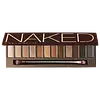What's inside
What's inside
 Key Ingredients
Key Ingredients

 Benefits
Benefits

No benefits
 Concerns
Concerns

 Ingredients Side-by-side
Ingredients Side-by-side

Acrylates Crosspolymer
AbsorbentAscorbyl Palmitate
AntioxidantCI 77163
Cosmetic ColorantCera Microcristallina
Emulsion StabilisingCeresin
Emulsion StabilisingChromium Hydroxide Green
Hydrogenated Cottonseed Oil
EmollientIron Oxides
Methylparaben
PreservativePolyethylene Terephthalate
Propylparaben
PreservativeSimmondsia Chinensis Seed Oil
EmollientCobalt Titanium Oxide
Skin ConditioningTocopherol
AntioxidantCI 19140
Cosmetic ColorantZinc Stearate
Cosmetic ColorantCI 42090
Cosmetic ColorantCyclopentasiloxane
EmollientMica
Cosmetic ColorantOzokerite
Emulsion StabilisingSodium Dehydroacetate
PreservativeBronzite Powder
Cosmetic ColorantEthylhexyl Palmitate
EmollientParaffin
PerfumingSorbic Acid
PreservativeC11-12 Isoparaffin
Skin ConditioningCI 75470
Cosmetic ColorantCI 77510
Cosmetic ColorantPhenoxyethanol
PreservativePolybutene
Talc
AbrasiveTin Oxide
AbrasiveAcrylates Crosspolymer, Ascorbyl Palmitate, CI 77163, Cera Microcristallina, Ceresin, Chromium Hydroxide Green, Hydrogenated Cottonseed Oil, Iron Oxides, Methylparaben, Polyethylene Terephthalate, Propylparaben, Simmondsia Chinensis Seed Oil, Cobalt Titanium Oxide, Tocopherol, CI 19140, Zinc Stearate, CI 42090, Cyclopentasiloxane, Mica, Ozokerite, Sodium Dehydroacetate, Bronzite Powder, Ethylhexyl Palmitate, Paraffin, Sorbic Acid, C11-12 Isoparaffin, CI 75470, CI 77510, Phenoxyethanol, Polybutene, Talc, Tin Oxide
 Reviews
Reviews

Ingredients Explained
These ingredients are found in both products.
Ingredients higher up in an ingredient list are typically present in a larger amount.
Ci 75470 is a bright-red pigment. It is AKA carmine.
Carmine is derived from insects such as the cochineal beetle. This ingredient has been used as a natural dye for over 2000 years.
Ethylhexyl Palmitate, also known as octyl palmitate, is created from 2-ethylhexyl alcohol and palmitic acid. It is a fatty acid ester.
The fatty acid content of Ethylhexyl Palmitate makes it an emollient. Emollients help soften and hydrate your skin by trapping moisture within.
Ethylhexyl Palmitate is also used to help improve the texture of cosmetics. It helps other ingredient dissolve in products and help disperse ingredients more evenly.
You'll likely find this ingredient in sunscreen, as it is often used to mix UV-blocking ingredients such as avobenzone and ethylhexyl triazone.
It can also help stabilize the fragrances in a product as a fragrance fixative.
Ethylhexyl Palmitate can be used to substitute mineral oil.
Due to its high fatty acid content, it may not be fungal-acne safe.
Learn more about Ethylhexyl PalmitateMica is a naturally occurring mineral used to add shimmer and color in cosmetics. It can also help improve the texture of a product or give it an opaque, white/silver color.
Serecite is the name for very fine but ragged grains of mica.
This ingredient is often coated with metal oxides like titanium dioxide. Trace amounts of heavy metals may be found in mica, but these metals are not harmful in our personal products.
Mica has been used since prehistoric times throughout the world. Ancient Egyptian, Indian, Greek, Roman, Aztec, and Chinese civilizations have used mica.
Learn more about MicaPhenoxyethanol is a preservative that has germicide, antimicrobial, and aromatic properties. Studies show that phenoxyethanol can prevent microbial growth. By itself, it has a scent that is similar to that of a rose.
It's often used in formulations along with Caprylyl Glycol to preserve the shelf life of products.
This ingredient is a preservative with antimicrobial properties. It is the sodium salt of dehydroacetic acid.
It is especially effective at preventing bacterial and fungal growth in low concentrations.
Sorbic Acid is a preservative. It is the most commonly used food preservative in the world.
Sorbic Acid is a natural antibiotic and highly effective at preventing the growth of fungus. It is less effective against bacteria.
Potassium Sorbate, another commonly-used preservative, is the potassium salt of Sorbic Acid.
Sorbic Acid may worsen eczema. We recommend speaking with a professional if you have any concerns.
Potassium sorbate and sorbic acid can be found in baked goods, cheeses, dried meats, dried fruit, ice cream, pickles, wine, yogurt, and more.
Learn more about Sorbic AcidTalc is a clay mineral. It helps absorb moisture and improve the texture of products. Like other types of clay, Talc can have a slight exfoliating effect on skin. Talc can be added to increase the volume of products.
Some Baby powders are made by combining talc with corn starch. The word "talc" comes from Latin and originates from Arabic. Talc is a mineral commonly found throughout the world.
If you have any concerns about using talc, we recommend checking out the FDA's official page.
Learn more about TalcTin Oxide is an inorganic oxide used to add opacity and volume to a product. In nature, it is already found in mineral form. The main ore of tin is an opaque and shiny mineral called casseterite.
Tin Oxide helps remove translucency in a product, or make it more opaque. Besides adding opacity, tin oxide is used for bulking to add volume.
Zinc Stearate is the metal salt of stearic acid. It is a white solid used to bind, thicken, and lubricate products.
This ingredient is common in powder makeup, where it helps keep the powder together.
Zinc Stearate is hydrophobic and repels water.
This ingredient can be sourced from non-animal or animal sources. It is best to reach out to the brand to see where they source this ingredient from.
Learn more about Zinc Stearate